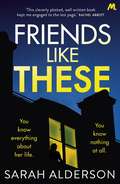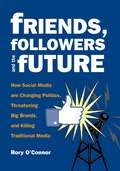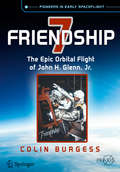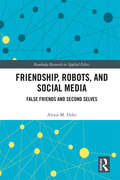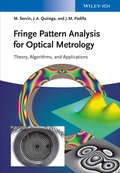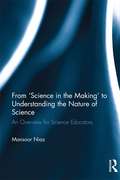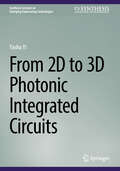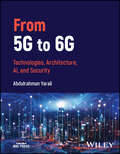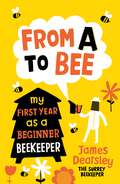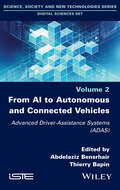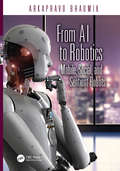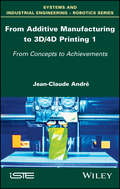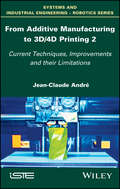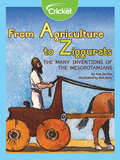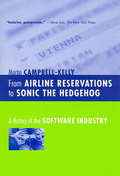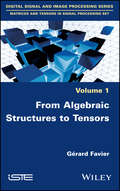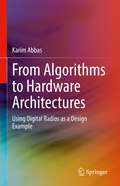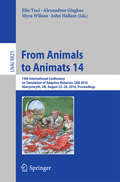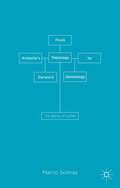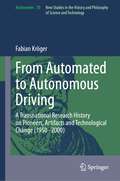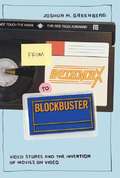- Table View
- List View
Friends Like These: A gripping psychological thriller with a shocking twist
by Sarah AldersonAs addictive as FRIEND REQUEST, as gripping as THE GIRL BEFORE.Lizzie hasn't thought much about Becca since the accident.She remembers the blood though. She can see how you wouldn't be the same again after something like that. No one was surprised when Becca didn't come back to work.And Lizzie's different these days too. She used to be the one in the shadows, stalking Becca's perfect life online, but a lot has changed since then.So when Becca's ex shows up on Tinder, Lizzie swipes right. Why not? Doesn't she deserve a chance at happiness as well?Becca will have moved on. There's no way she'd even remember Lizzie, no way she could know anything about her life - is there? She's about to find out that with a friend like Becca, she doesn't need enemies...
Friends Like These: A gripping psychological thriller with a shocking twist
by Sarah AldersonA gripping thriller about fake friendships and the truth that lies behind the Facebook page, for fans of The Girlfriend and Friend Request.We all know someone like Becca. She has the job everyone wants, a designer wardrobe, a hot-shot lawyer boyfriend, holidays to exotic locations. And she flaunts her perfect life all over social media. It drove her colleague Lizzie mad, but she couldn't stop looking. They were never really friends - and yet Lizzie knew everything about her. Or did she? When chance, and a terrible mistake, pulls Lizzie back into Becca's orbit years after they lost touch, she'll realise that you can't always believe what you see online... and that finding out the truth might be the worst thing you can do. There's no such thing as a perfect life. Only a perfect lie.(P)2018 Hodder & Stoughton Limited
Friends, Followers and the Future
by Rory O'Connor"Rory O'Connor is one of the smartest media guys around. He knows who's spinning, who's pandering, and who's putting money in his own pocket at the expense of logic, reason, and the public good."-Michael Wolff, Vanity Fair media criticThere's a revolution going on, as ever-accelerating developments in digital information technologies change nearly every aspect of how we live, work, play, do business, and engage in politics. Share and share alike-the numbers say it all as billions of people worldwide flock to online media and use social networks to discover and spread news and information.In the process, ever-growing networks of "ordinary people" are using these powerful new tools to trim the influence long held by Big Business, Big Government, and Big Media. No longer just passive recipients, participants in social networks now regularly make and break news while organizing civic and political actions that bypass censors, outpace traditional media, attract massive audiences, and influence the rise and fall of brands, industries, politicians, and even governments.In this insider's look at how social media are transforming our world, Rory O'Connor explains the trends and explores what tech visionaries, media makers, political advisers, and businesspeople are saying about the meteoric rise of the various social networks of friends and followers, and what they bode for our future.Rory O'Connor, co-founder of MediaChannel.org, is the author of Shock Jocks: Hate Speech & Talk Radio. He has won two Emmys and a George Orwell Award, among many other honors.
Friendship 7
by Colin BurgessIn this spellbinding account of an historic but troubled orbital mission, noted space historian Colin Burgess takes us back to an electrifying time in American history, when intrepid pioneers were launched atop notoriously unreliable rockets at the very dawn of human space exploration. A nation proudly and collectively came to a standstill on the day this mission flew; a day that will be forever enshrined in American spaceflight history. On the morning of February 20, 1962, following months of frustrating delays, a Marine Corps war hero and test pilot named John Glenn finally blazed a path into orbit aboard a compact capsule named Friendship 7. The book's tension-filled narrative faithfully unfolds through contemporary reports and the personal recollections of astronaut John Glenn, along with those closest to the Friendship 7 story, revealing previously unknown facts behind one of America's most ambitious and memorable pioneering space missions. Friendship 7. The book's tension-filled narrative faithfully unfolds through contemporary reports and the personal recollections of astronaut John Glenn, along with those closest to the Friendship 7 story, revealing previously unknown facts behind one of America's most ambitious and memorable pioneering space missions. Friendship 7 story, revealing previously unknown facts behind one of America's most ambitious and memorable pioneering space missions.
Friendship, Robots, and Social Media: False Friends and Second Selves (Routledge Research in Applied Ethics)
by Alexis M. ElderVarious emerging technologies, from social robotics to social media, appeal to our desire for social interactions, while avoiding some of the risks and costs of face-to-face human interaction. But can they offer us real friendship? In this book, Alexis Elder outlines a theory of friendship drawing on Aristotle and contemporary work on social ontology, and then uses it to evaluate the real value of social robotics and emerging social technologies. In the first part of the book Elder develops a robust and rigorous ontology of friendship: what it is, how it functions, what harms it, and how it relates to familiar ethical and philosophical questions about character, value, and well-being. In Part II she applies this ontology to emerging trends in social robotics and human-robot interaction, including robotic companions for lonely seniors, therapeutic robots used to teach social skills to children on the autism spectrum, and companionate robots currently being developed for consumer markets. Elder articulates the moral hazards presented by these robots, while at the same time acknowledging their real and measurable benefits. In the final section she shifts her focus to connections between real people, especially those enabled by social media. Arguing against critics who have charged that these new communication technologies are weakening our social connections, Elder explores ways in which text messaging, video chats, Facebook, and Snapchat are enabling us to develop, sustain, and enrich our friendship in new and meaningful ways.
Fringe Pattern Analysis for Optical Metrology
by Moises Padilla Manuel Servin J. Antonio QuirogaThe main objective of this book is to present the basic theoretical principles and practical applications for the classical interferometric techniques and the most advanced methods in the field of modern fringe pattern analysis applied to optical metrology. A major novelty of this work is the presentation of a unified theoretical framework based on the Fourier description of phase shifting interferometry using the Frequency Transfer Function (FTF) along with the theory of Stochastic Process for the straightforward analysis and synthesis of phase shifting algorithms with desired properties such as spectral response, detuning and signal-to-noise robustness, harmonic rejection, etc.
Froggy Builds a Tree House
by Jonathan LondonFroggy and his friends are building a treehouse-with a lot of help from Dad. Their plans don't include Frogilina though. "Boys Only!" says Froggy. But in the end, it's Frogilina who saves the day and joins the treehouse gang. Lovable Froggy returns in his 22nd laugh-out-loud adventure.
From 'Science in the Making' to Understanding the Nature of Science: An Overview for Science Educators
by Mansoor NiazThe Nature of Science is highly topical among science teacher educators and researchers. Increasingly, it is a mandated topic in state curriculum documents. This book draws together recent research on Nature of Science studies within a historical and philosophical framework suitable for students and teacher educators. Traditional science curricula and textbooks present science as a finished product. Taking a different approach, this book provides a glimpse of “science in the making” — scientific practice imbued with arguments, controversies, and competition among rival theories and explanations. Teaching about “science in the making” is a rich source of motivating students to engage creatively with the science curriculum.Readers are introduced to “science in the making” through discussion and analysis of a wide range of historical episodes from the early 19th century to early 21st century. Recent cutting-edge research is presented to provide insight into the dynamics of scientific progress. More than 90 studies from major science education journals, related to nature of science are reviewed. A theoretical framework, field tested with in-service science teachers, is developed for moving from ‘science in the making’ to understanding the Nature of Science.
From 2D to 3D Photonic Integrated Circuits (Synthesis Lectures on Emerging Engineering Technologies)
by Yasha YiThe integration of photonics and electronics has transformed the landscape of modern technology. At the forefront of this revolution is the development of Photonic Integrated Circuits (PICs). Historically rooted in the traditional 2-D fabrication processes inherited from electronic Integrated Circuits, PICs shifted to 3-D configurations, introducing new design philosophies that impact scalability, efficiency, and performance. This convergence of electronic and photonic circuits presents unique challenges and great opportunities. This book provides an introduction to photonic integrated circuits and the transition from 2D to 3D PICs. It then describes design and fabrication techniques of 3D PICs and related challenges and solutions. Finally, applications of 3D photonics, emerging technologies and industry outlook are also discussed.
From 5G to 6G: Technologies, Architecture, AI, and Security
by Abdulrahman YaraliFrom 5G to 6G Understand the transition to the sixth generation of wireless with this bold introduction The transition from the fifth generation of wireless communication (5G) to the coming sixth generation (6G) promises to be one of the most significant phases in the history of telecommunications. The technological, social, and logistical challenges promise to be significant, and meeting these challenges will determine the future of wireless communication. Experts and professionals across dozens of fields and industries are beginning to reckon seriously with these challenges as the 6G revolution approaches. From 5G to 6G provides an overview of this transition, offering a snapshot of a moment in which 5G is establishing itself and 6G draws ever nearer. It focuses on recent advances in wireless technology that brings 6G closer to reality, as well as the near-term challenges that still have to be met for this transition to succeed. The result is an essential book for anyone wishing to understand the future of wireless telecommunications in an increasingly connected world. From 5G to 6G readers will also find: 6G applications to both AI and Machine Learning, technologies which loom ever larger in wireless communication Discussion of subjects including smart healthcare, cybersecurity, extended reality, and more Treatment of the ongoing infrastructural and technological requirements for 6G From 5G to 6G is essential for researchers and academics in wireless communication and computer science, as well as for undergraduates in related subjects and professionals in wireless-adjacent fields.
From A to Bee: My First Year as a Beginner Beekeeper
by James DearsleyJames Dearsley’s wife thought he had lost his mind when he announced his intention to become a beekeeper. Like many interested in self-sufficiency, he loved gardening and growing vegetables and he wanted to teach his little boy where honey came from, so he set himself a goal: to get, in a year’s time, just one jar of honey.
From A to Bee: My First Year as a Beginner Beekeeper
by James DearsleyJames Dearsley’s wife thought he had lost his mind when he announced his intention to become a beekeeper. Like many interested in self-sufficiency, he loved gardening and growing vegetables and he wanted to teach his little boy where honey came from, so he set himself a goal: to get, in a year’s time, just one jar of honey.
From AI to Autonomous and Connected Vehicles: Advanced Driver-Assistance Systems (ADAS)
by Abdelaziz Bensrhair Thierry BapinThe main topic of this book is the recent development of on-board advanced driver-assistance systems (ADAS), which we can already tell will eventually contribute to the autonomous and connected vehicles of tomorrow.With the development of automated mobility, it becomes necessary to design a series of modules which, from the data produced by on-board or remote information sources, will enable the construction of a completely automated driving system. These modules are perception, decision and action. State-of-the-art AI techniques and their potential applications in the field of autonomous vehicles are described.Perception systems, focusing on visual sensors, the decision module and the prototyping, testing and evaluation of ADAS systems are all presented for effective implementation on autonomous and connected vehicles.This book also addresses cooperative systems, such as pedestrian detection, as well as the legal issues in the use of autonomous vehicles in open environments.
From AI to Robotics: Mobile, Social, and Sentient Robots
by Arkapravo BhaumikFrom AI to Robotics: Mobile, Social, and Sentient Robots is a journey into the world of agent-based robotics and it covers a number of interesting topics, both in the theory and practice of the discipline. The book traces the earliest ideas for autonomous machines to the mythical lore of ancient Greece and ends the last chapter with a debate on a prophecy set in the apparent future, where human beings and robots/technology may merge to create superior beings – the era of transhumanism. Throughout the text, the work of leading researchers is presented in depth, which helps to paint the socio-economic picture of how robots are transforming our world and will continue to do so. This work is presented along with the influences and ideas from futurists, such as Asimov, Moravec, Lem, Vinge, and of course Kurzweil. The book furthers the discussion with concepts of Artificial Intelligence and how it manifests in robotic agents. Discussions across various topics are presented in the book, including control paradigm, navigation, software, multi-robot systems, swarm robotics, robots in social roles, and artificial consciousness in robots. These discussions help to provide an overall picture of current day agent- based robotics and its prospects for the future. Examples of software and implementation in hardware are covered in Chapter 5 to encourage the imagination and creativity of budding robot enthusiasts. The book addresses several broad themes, such as AI in theory versus applied AI for robots, concepts of anthropomorphism, embodiment and situatedness, extending theory of psychology and animal behavior to robots, and the proposal that in the future, AI may be the new definition of science. Behavior-based robotics is covered in Chapter 2 and retells the debate between deliberative and reactive approaches. The text reiterates that the effort of modern day robotics is to replicate human-like intelligence and behavior, and the tools that a roboticist has at his or her disposal are open source software, which is often powered by crowd-sourcing. Open source meta-projects, such as Robot Operating System (ROS), etc. are briefly discussed in Chapter 5. The ideas and themes presented in the book are supplemented with cartoons, images, schematics and a number of special sections to make the material engaging for the reader. Designed for robot enthusiasts – researchers, students, or the hobbyist, this comprehensive book will entertain and inspire anyone interested in the exciting world of robots.
From Additive Manufacturing to 3D/4D Printing 1: From Concepts to Achievements
by Jean-Claude AndréIn 1984, additive manufacturing represented a new methodology for manipulating matter, consisting of harnessing materials and/or energy to create three-dimensional physical objects. Today, additive manufacturing technologies represent a market of around 5 billion euros per year, with an annual growth between 20 and 30%. Different processes, materials and dimensions (from nanometer to decameter) within additive manufacturing techniques have led to 70,000 publications on this topic and to several thousand patents with applications as wide-ranging as domestic uses. Volume 1 of this series of books presents these different technologies with illustrative industrial examples. In addition to the strengths of 3D methods, this book also covers their weaknesses and the developments envisaged in terms of incremental innovations to overcome them.
From Additive Manufacturing to 3D/4D Printing 2: Current Techniques, Improvements and their Limitations
by Jean-Claude AndréAdditive manufacturing, which was first invented in France and then applied in the United States, is now 33 years old and represents a market of around 5 billion euros per year, with annual growth of between 20 and 30%. Today, additive manufacturing is experiencing a great amount of innovation in its processes, software, engineering and materials used. Its strength as a process has more recently allowed for the exploration of new niches, ranging from applications at nanometer and decameter scales, to others in mechanics and health. As a result, the limitations of the process have also begun to emerge, which include the quality of the tools, their cost of manufacture, the multi-material aspects, functionalities and surface conditions. Volume 2 of this series presents the current techniques, improvements and limits of additive manufacturing, providing an up-to-date review of this process.
From Agriculture to Ziggurats: The Many Inventions of the Mesopotamians
by Ann JordanThousands of years ago, the Mesopotamians made many discoveries that we enjoy today.
From Airline Reservations to Sonic the Hedgehog: A History of the Software Industry (History of Computing)
by Martin Campbell-KellyA business history of the software industry from the days of custom programming to the age of mass-market software and video games.From its first glimmerings in the 1950s, the software industry has evolved to become the fourth largest industrial sector of the US economy. Starting with a handful of software contractors who produced specialized programs for the few existing machines, the industry grew to include producers of corporate software packages and then makers of mass-market products and recreational software. This book tells the story of each of these types of firm, focusing on the products they developed, the business models they followed, and the markets they served. By describing the breadth of this industry, Martin Campbell-Kelly corrects the popular misconception that one firm is at the center of the software universe. He also tells the story of lucrative software products such as IBM's CICS and SAP's R/3, which, though little known to the general public, lie at the heart of today's information infrastructure.With its wealth of industry data and its thoughtful judgments, this book will become a starting point for all future investigations of this fundamental component of computer history.
From Algebraic Structures to Tensors
by Gérard FavierNowadays, tensors play a central role for the representation, mining, analysis, and fusion of multidimensional, multimodal, and heterogeneous big data in numerous fields. This set on Matrices and Tensors in Signal Processing aims at giving a self-contained and comprehensive presentation of various concepts and methods, starting from fundamental algebraic structures to advanced tensor-based applications, including recently developed tensor models and efficient algorithms for dimensionality reduction and parameter estimation. Although its title suggests an orientation towards signal processing, the results presented in this set will also be of use to readers interested in other disciplines. This first book provides an introduction to matrices and tensors of higher-order based on the structures of vector space and tensor space. Some standard algebraic structures are first described, with a focus on the hilbertian approach for signal representation, and function approximation based on Fourier series and orthogonal polynomial series. Matrices and hypermatrices associated with linear, bilinear and multilinear maps are more particularly studied. Some basic results are presented for block matrices. The notions of decomposition, rank, eigenvalue, singular value, and unfolding of a tensor are introduced, by emphasizing similarities and differences between matrices and tensors of higher-order.
From Algorithms to Hardware Architectures: Using Digital Radios as a Design Example
by Karim AbbasThis book uses digital radios as a challenging design example, generalized to bridge a typical gap between designers who work on algorithms and those who work to implement those algorithms on silicon. The author shows how such a complex system can be moved from high-level characterization to a form that is ready for hardware implementation. Along the way, readers learn a lot about how algorithm designers can benefit from knowing the hardware they target and how hardware designers can benefit from a familiarity with the algorithm. The book shows how a high-level description of an algorithm can be migrated to a fixed-point block diagram with a well-defined cycle accurate architecture and a fully documented controller. This can significantly reduce the length of the hardware design cycle and can improve its outcomes. Ultimately, the book presents an explicit design flow that bridges the gap between algorithm design and hardware design.Provides a guide to baseband radio design for Wi-Fi and cellular systems, from an implementation-focused, perspective;Explains how arithmetic is moved to hardware and what the cost of each operation is in terms of delay, area and power;Enables strategic architectural decisions based on the algorithm, available processing units and design requirements.
From Animals to Animats 14
by Elio Tuci Alexandros Giagkos Myra Wilson John HallamThis book constitutes the proceedings of the 14th International Conference on Simulation of Adaptive Behavior, SAB 2016, held in Aberystwyth, UK, in August 2016. The 31 papers presented in this volume were carefully reviewed and selected from 45 submissions. They cover the main areas in animat research, including the animat approach and methodology, perception and motor control, learning and adaptation, evolution, and collective and social behavior.
From Aristotle’s Teleology to Darwin’s Genealogy
by Marco SolinasStarting with Aristotle and moving on to Darwin, Marco Solinas outlines the basic steps from the birth, establishment and later rebirth of the traditional view of living beings, and its overturning by evolutionary revolution. The classic framework devised by Aristotle was still dominant in the 17th Century world of Galileo, Harvey and Ray, and remained hegemonic until the time of Lamarck and Cuvier in the 19th Century. Darwin's breakthrough thus takes on the dimensions of an abandonment ofthe traditional finalistic theory. It was a transition exemplified in the morphological analysis of useless parts, such as the sightless eyes of moles, already discussed by Aristotle, which Darwin used as a crowbar to unhinge the systematic recourse to final causes. With many excerpts, a chronological sequence and an analytical approach, this book follows the course of the two conceptions that have shaped the destiny of living beings in western culture.
From Automated to Autonomous Driving: A Transnational Research History on Pioneers, Artifacts and Technological Change (1950-2000) (Archimedes #70)
by Fabian KrögerThis book presents the most important milestones of the research on automated and autonomous driving in the United States, Japan and Europe throughout five decades (1950-2000). Drawing on sources from the automotive industry, electrical engineering, the robotics and AI-domain and military institutions, it retraces the transition from the guidance-cable approach to vehicle-based sensor and vision systems. Giving a detailed overview of the technical concepts, artefacts, research vehicles and robots, the book presents the transnational engineering efforts that started long before Silicon Valley entered the field. In addition, the book also uniquely details the role of the military in the domain of vehicle automation. This all ensures the book is of great interest to historians of technology, practitioners in engineering disciplines, scholars working in mobility studies, journalists, and political decision makers.
From Betamax to Blockbuster: Video Stores and the Invention of Movies on Video
by Joshua GreenbergGreenberg's account offers a fresh perspective on consumer technology, illustrating how the initial transformation of movies from experience into commodity began not from the top down or the bottom up, but from the middle of the burgeoning industry out.
From Big Oil to Big Green: Holding the Oil Industry to Account for the Climate Crisis
by Marco GrassoHow Big Oil can transform itself into Big Green through reparation and decarbonization to rectify the harm it has done through fossil fuels. In From Big Oil to Big Green, Marco Grasso examines the responsibility of the oil and gas industry for the climate crisis and develops a moral framework that lays out its duties of reparation and decarbonization to allay the harm it has done. By framing climate change as a moral issue and outlining the industry&’s obligation to tackle it, Grasso shows that Big Oil is a central, yet overlooked, agent of climate ethics and policy. Grasso argues that by indiscriminately flooding the global economy with fossil fuels—while convincing the public that halting climate change is a matter of consumer choice, that fossil fuels are synonymous with energy, and that a decarbonized world would take civilization back to the Stone Age—Big Oil is morally responsible for the climate crisis. He explains that it has managed to avoid being held financially accountable for past harm and that its duty of reparation has never been theoretically developed or justified. With this book, he fills those gaps. After making the moral case for climate reparations and their implementation, Grasso develops Big Oil&’s duty of decarbonization, which entails its transformation into Big Green by phasing out carbon emissions from its processes and, especially, its products.
